#it's funerary wear
Explore tagged Tumblr posts
Text

He's spilling the ✨tea✨
Today's silly Emmrich brought to you by the Warm-Up Bean Wheel™️! Suggestions are open as to what startled the poor professor so . . .
Want to see your blorbo bean-ified? Send me an ask and I’ll add them to my warm-up bean wheel!
#you cant tell me that mr. i-wear-all-my-funerary-gold-at-all-times volkarin#wouldnt have AT LEAST 1 (one) tasteful little earring#dragon age#dragon age the veilguard#datv#emmrich volkarin#datv emmrich#dragon age emmrich#artists on tumblr#my art#2025#beans!
27 notes
·
View notes
Text
Skull portraiture is amazing and it's a real shame that hasn't stuck around as a wide cultural practice.
Check out this amazing art from 9000 years ago:
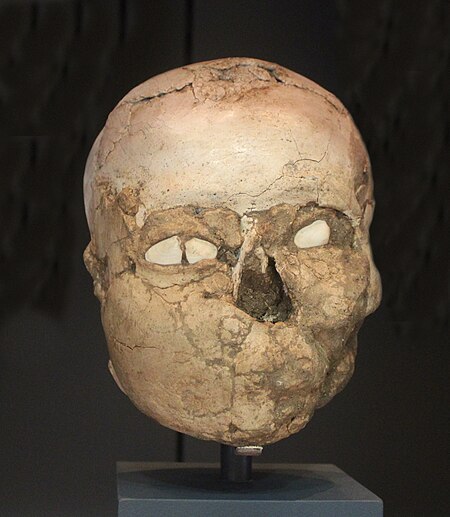
More than 4000 years before the dynasties of Egypt, people were treating the dead in truly reverent and beautiful ways. It leaves me with little wonder that so many religious beliefs professed life's creation from clay. A skilled neolithic artist could keep a loved one with them for years after death by use of clay.
Would that your face looked that good 9000 years after death.
#the dawn of everything#is the book where I first learned about this#and I don't think they explicitly attributed reasoning to it#like we can't really know for sure why they did this stuff#but it seems so natural#to not want to give up a loved one#even to death#and this was a means they had to keep their visage around at least#surely the clay work would have been done to mimic the living person's appearance as much as they could manage#also I was reminded that ancient romans had funerary masks#they'd wear on certain occasions which resembled their deceased relatives/ancestors#like those were real people with inner lives as deep as ours#9000 years ago and before#it's wild and yet of course they were#why wouldn't they have been?#the immutable and timeless quality of humanity is really humbling
2 notes
·
View notes
Text

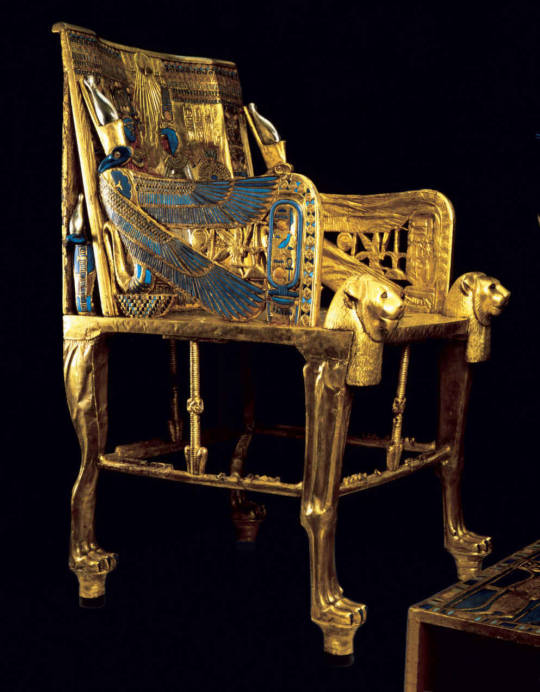



Golden Throne of Tutankhamun
New Kingdom, late 18th Dynasty, reign of Tutankhamun, ca. 1332-1323 BC.
The luxurious armchair is distinguished by the complexity of its technique and an abundance of details. Two projecting lions’ heads protect the seat of the throne while the arms take the form of winged uraei or rearing cobras wearing the double Pschent crown of Egypt and guarding the cartouche names of the king.
The golden throne of Tutankhamun was discovered in 1922 by the British archeologist Howard Carter. It was found beneath a hippopotamus funerary bed in the antechamber of the Tomb of Tutankhamun.
The throne is called (Ist) in Egyptian hieroglyphs after the name of the mother goddess Isis. who was usually depicted bearing a throne on her head as her characteristic emblem. It is made of wood and covered with gold and silver. It is ornamented with semi-precious stones and colored glass.
The throne meant, not only the link between the worlds of Gods and the people, but also majesty, stability, safety and balance. Since kings were considered Gods on earth, it may not be difficult to imagine Tutankhamun imposing his divine will over the rest of mortals while sitting on this golden throne.
Wood, gold leaf, silver, semi-precious stones, glass paste,
Height: 102 cm, Length: 54 cm, Width: 60 cm,
Egyptian Museum, Cairo.
#art#design#history#luxury lifestyle#style#furniture#throne#gold#tutankhamun#egypt#gold leaf#glass#wood#gods#egyptienmuseum#cairo#tomb#new kingdom#armchair
2K notes
·
View notes
Text
I'm thoroughly convinced that in any sort of modern-day AU, Rook and Emmrich are the couple whose first date basically just never ends. There's a meet-cute. They meet in the grocery store when they both reach for the same jar of pickled eggs. Or in an elevator of a fancy hotel where Emmrich is attending a conference and Rook is on a galpal's bachelorette vacay. Or at a blood drive where Emmrich is grading papers and Rook is reading the trashiest novel she could get her hands on.
They hit it off. Emmrich, of course, finds Rook charming and Emmrich is, of course, the king of unassuming rizz. They exchange numbers. They go on a date that weekend to some stuffy gastropub that Emmrich apologizes for recommending no less than six times mostly because Rook looks at the prices on the menu with the kind of dismay that Emmrich remembers from being young and poor and hungry.
He pays for their meal, of course, and utterly insists that she order dessert.
They go for a walk. They Uber home, again on Emmrich's dime. Emmrich walks Rook up to her doorstep and intends to leave her with a quick peck, maybe even on the cheek, and a promise to call --but Rook slinks her arms around his neck and presses her body to his and invites him up.
"Terribly sorry," Emmrich half-yells into the Uber driver's passenger side window "It seems we're both staying here! I have--a tip--" He shoves a twenty dollar bill through the cracked window. It flutters anticlimactically onto the passenger seat. "Here you go!"
Rook's apartment is small, cluttered but clean, and they do not reach the bedroom. Emmrich fucks her on the sofa, which is second-hand and which they sink into alarmingly far, and they enjoy the afterglow together by scrolling through late-night offerings on a delivery app because Rook mentions that the gastropub's serving sizes were abysmal. They order a pizza, and Rook eats wearing nothing but her lacy purple thong and Emmrich's discarded white button-up. Emmrich watches her and feels his heart nervously flutter.
He stays the night.
In the morning, he plans to make her coffee and offer some eggs and then take his leave, because it seems polite and he has no reason to think she wouldn't want her Sunday to herself. Instead, Rook drinks the coffee, pops out of her chair and mentions that there is an Antivan bakery just down the street if he wants to walk with her.
He does, of course.
"I'm applying to graduate programs right now," Rook tells him, chewing on a biscotti, cute fingers wrapped around a second coffee. They sit in the window of the bakery on a pair of charmingly previous-century wrought iron bistro chairs. "There's one program...I want it so badly, but they only accept six candidates every three years. I've been out of school for a few years and I was going through some stuff in undergrad, so my GPA wasn't the greatest. I'l doubt I'll get in."
"Which program?" Emmrich inquires. Each of their pairs of legs are folded under the table, his right-over-left and hers left-over-right. They periodically tap their feet together and each time it happens, he smiles.
"It's a fellowship to study at the Grand Necropolis," Rook tells him. "Specifically, their program on funerary practices from the turn of the first millenium, which is--what?"
"Oh," Emmrich says, a little flustered. "Nothing, it's just--well, I'm tenured at the Necropolis. I know exactly the person who will be reading your application. It's not my program, of course, but I could...would you like me to look over your application? I know what she'll be looking for."
This is how Emmrich ends up sitting at Rook's dining room table well into the afternoon, reading through her extensive application to the Necropolis' fellowship program. She's undersold herself extensively--and he tries to aim her in a better direction while also not getting any of his fingerprints on the application. Myrna would easily be able to tell if she was reading an application written by someone who she'd eaten brunch with once a month for the past eight years.
"I should probably be going," Emmrich says, stretching out his back after several hours. "I have a...well, my bird gets nervous if I'm gone for long periods of time."
"You have a bird?" Rook asks, with delight, and this is how he ends up being driven back to his place by an overly-excited Rook, who apparently had a childhood dream of owning a parrot.
Manfred seems equally fascinated by her, as he hops onto her shoulder and makes a serious of hisses.
"His previous home evidently had cats," Emmrich tells her, gently petting the top of Manfred's head, and Manfred displays his other skill--screeching 'Emmrich!' over and over.
This is when things start to blur. Emmrich makes dinner, they eat, watch an episode of whatever is on the TV, and then have sex again--in the bed this time, Rook on top, hair down, and she looks...well, he doesn't last long.
In the morning, she goes to work. Texts him in the middle of the day to ask if he likes Tevinter food. He says yes, and she asks if he's free that evening. Also yes.
It's about a week later that Emmrich realizes they haven't spent much more than a workday apart since Saturday. It being Saturday again, Emmrich mentions it.
"Oh," says Rook, looking suddenly unsure. "I'm sorry, did you--if you need me to go, I can--"
"No!" Emmrich all but yells. "I just meant--am I monopolizing your time? Do you have...things I'm, er, keeping you from?"
Rook settles back against the sofa, which she's been lounging on beautifully on this rainy Saturday morning in Emmrich's pajama top and underneath Emmrich's mother's crochet blanket.
"Most of my friends are also, y'know, busy professionals," Rook sighs, head leaning on her hand, hair draping. "It's hard to make time. And I don't have family, really. I can leave if you want, really, I would understand. I just got a little carried away because--well, it's nice. To have someone to come home to." She frowns. "I don't know, is that weird to say?"
"No," Emmrich says, tears watering in alarming fashion. "No, darling, it makes perfect sense."
Everyone is only vaguely concerned when Rook moves into Emmrich's place a month later.
"It's not like we're getting married," Rook scoffs repeatedly.
Except that they do, before the end of the year. By that point, however, it seems that everyone has made peace with the situation--mostly because they finish each other's sentences, and sigh like lovelorn puppy dogs when they're apart, and mostly because nobody can really imagine them any other way nowadays.
472 notes
·
View notes
Text
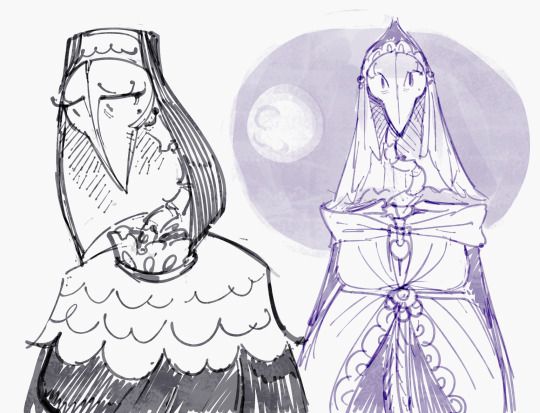
i like to think they actually change how they look every rift event come, i mean it would get boring to wear the same things for so long, and it does look like Thespius can Wear other clothes after all, so Mitter didnt ALWAYS wear the black ensemble, honestly she was barely covered when she first ascended, only covered by a funerary cloth.
#great god grove#miss mitternacht#ggg miss mitternacht#samsa´s art stuff#i love her very much conceptually shes fascinating . god as an actual person rather than an omnipotent concept#ascended by the will of her people to be the pillar of humanity#in profound loneliness for so so so so long dealing with the rift by herself. each time a little more strained until ! company arrives!
522 notes
·
View notes
Text
I need father brian hot-priest (double-barrelled surname) to be at the funeral and I need him to somehow end up standing with buck and eddie and tommy and just be metaphorically or perhaps literally eating popcorn in a solemn and funerary manner whilst watching whatever the fuck unfolds
(and afterwards he maybe leans over to eddie and murmurs 'I'm happy to see you took my advice' and eddie's like 'who told you???'
father brian hot-priest: it's sort of obvious :)
eddie: *glances down to check he's wearing pants*)
#9-1-1#911 spoilers#911 speculation#buddie#weewoo husbands (I'm sorry)#really I think father brian hot-priest should just be present and watching every scene that unfolds. he's the audience proxy in my heart no#father brian hot-priest
289 notes
·
View notes
Text
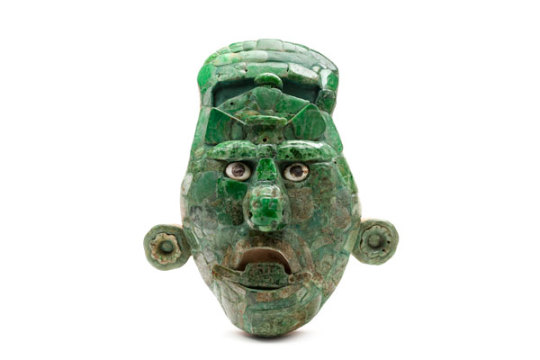
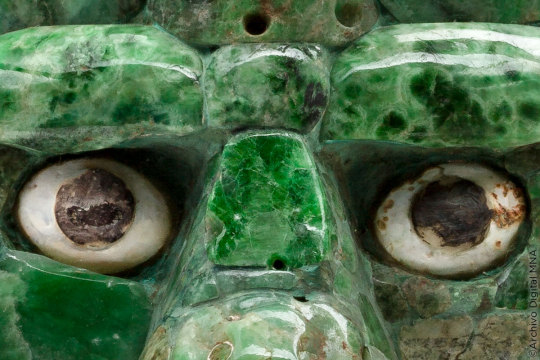
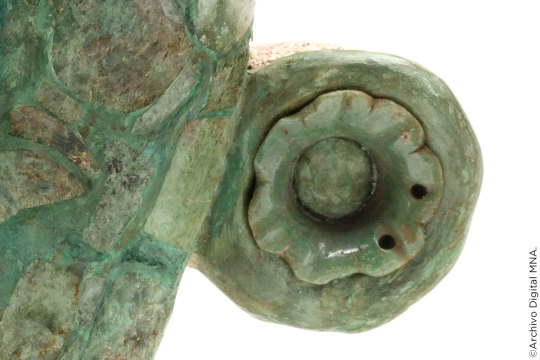
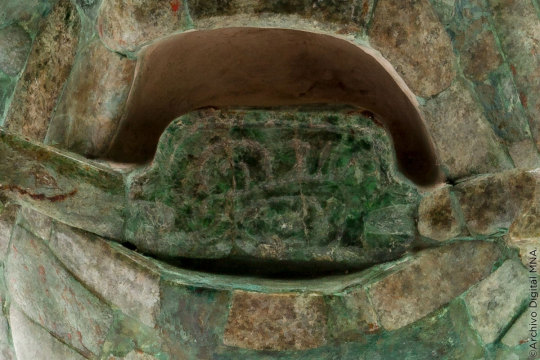
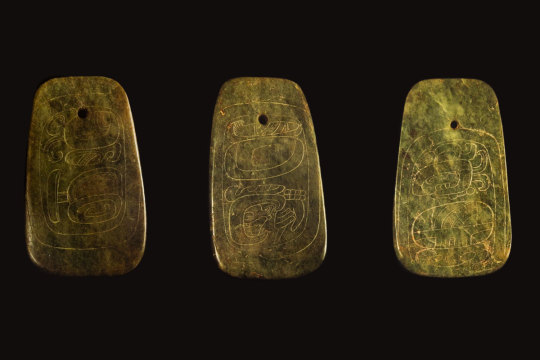

~ The royal belt of Calakmulhul.
▪︎ Towards mid-November 1988, researchers from the Calakmul Project discovered in Building III a crypt that housed the remains of an ancient sovereign accompanied by a modest funerary trousseau. Among the objects deposited in the tomb were three green stone masks. One must have been placed on his face, the other two smaller ones were interpreted as medallions or pectorals.
The belt was part of the dignitaries' attire, as can be seen in some steles. It was made up of a small mask from which three green stone axes hung. The masks represented deities or embodied ancestors. The axes, when hitting each other, generate a tinkling sound that is heard like the murmur of the wind. By wearing the belt, the rulers were transfigured into the axis mundi , in the center of the Universe.
#history#museum#archeology#archaeology#the royal belt of calakmul#calakmul#masks#ancient#ancient art#ancient history#pectoral#axis mundis#mexican#mexico#Mesoamerica#pre columbian
1K notes
·
View notes
Text

Archaeologists Have Found a Hoard of 2,600-Year-Old Gold Jewelry at Karnak Temple in Egypt
Archaeologists in Egypt have discovered a 2,600-year-old pot full of gold jewelry, including a rare statuette that depicts a family of gods and may have been worn as an amulet.
A team found the pot at Karnak Temple, a complex near Luxor (ancient Thebes). The temple was initially built around 4,000 years ago and was continuously expanded, renovated and modified over millennia. A number of deities were worshipped at the site, including Amun, the chief god of Thebes.
The finds include beads, amulets and statuettes, many of which are gold, according to a translated statement from the Egyptian Ministry of Tourism and Antiquities.
They "were discovered in the northwestern sector of the Karnak Temple complex," Abdelghaffar Wagdy, an archaeologist with the Egyptian Ministry of Tourism and Antiquities who is co-leader of the team, said in an email. "This area is suspected to have housed administrative and storage facilities."




One of the most remarkable finds is a gold statuette that depicts the deities Amun, Khonsu and Mut standing beside each other. These gods were a family: Amun was the chief god of Thebes, his wife Mut was a mother goddess, and their son Khonsu was a moon god. All three gods were associated with Thebes, and depictions of the three together have been found in previous excavations in Egypt. The statuette may have been worn on the neck like an amulet, Wagdy said.
"The depiction of the Theban Triad on the amulet likely symbolizes the devotion to the divine family of Amun, Mut, and Khonsu," Wagdy said, noting that the person who owned it may have been hoping to receive divine protection.
"The golden triad of Amun, Mut and Khonsu is intricately designed and is right at home in Karnak Temple, as [this] cult temple is dedicated for the [worship] of these three deities," said Shelby Justl, an Egyptologist and lecturer in the critical writing program at the University of Pennsylvania who is not part of the excavation team.
Some of the amulets found in the pot are wadjet (also spelled wedjet) amulets, which are eye-shaped amulets that "for the Egyptians, imbues healing power and symbolizes rebirth," "An amulet in this shape was thought to protect its wearer and to transfer the power of regeneration onto him or her."
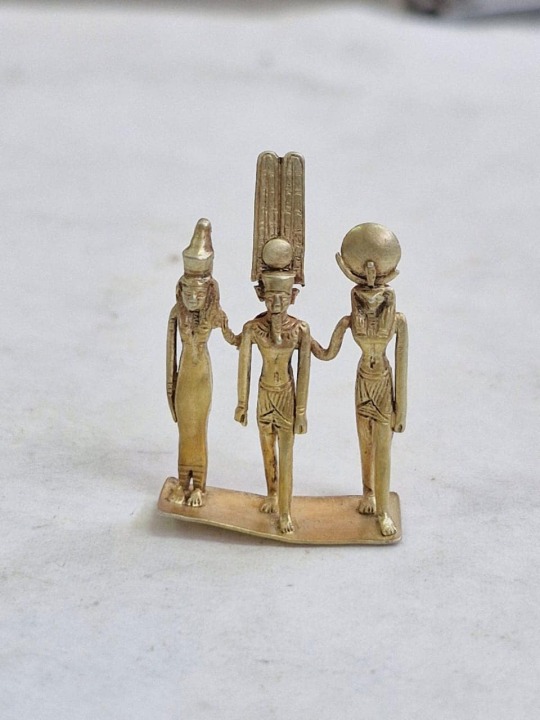
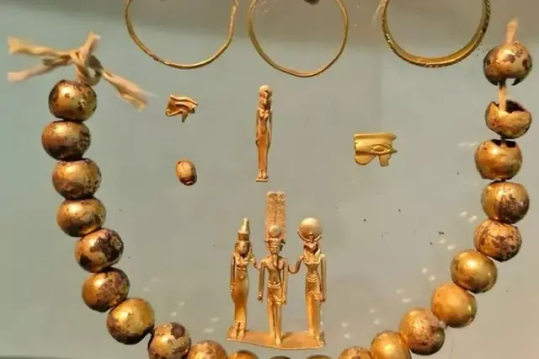
Why was the jewelry buried in a pot?
It's unclear why the jewelry was buried in a pot. "The collection appears to be typical of a rare type of 'cache' or 'hoard' of valuable precious metals buried for uncertain reasons," Peter Brand, a history professor at the University of Memphis in Tennessee who is not part of the excavation team, said in an email.
Wagdy said there are a number of possibilities, including that the jewelry could be votive offerings given to the deities during a ritual. Or perhaps they were a donation to the temple treasury. Another possibility is that they were buried for safekeeping during a time of political unrest in the area.
"Finding so many beautifully crafted items of gold together and in a location associated with the living and not a grave is rare," Justl said, noting that it's possible that the jewelry was manufactured in nearby workshops and sealed in the pot to prevent the items from being stolen.
Jack Ogden, a jewelry historian who has conducted extensive research on Egyptian jewelry but is not part of the excavation team, noted that the jewelry seems to have been designed for burial and not everyday wear.
"The goldwork appears from the photos to be fairly flimsy, so one suspects that it was purely funerary," Ogden said. The area near Karnak Temple contains many tombs, Ogden said, and it's possible that an ancient grave robber stole the jewelry but had to unexpectedly hide their stash.
"One explanation is that it was an ancient tomb robber's haul concealed for safety but never recovered," Ogden said. "It would be useful for whoever studies it all to try to work out if the breaks and damage were likely caused by less-than-gentle removal from a mummy."
By Owen Jarus.



#Archaeologists Have Found a Hoard of 2600-Year-Old Gold Jewelry at Karnak Temple in Egypt#Karnak Temple#gold#gold jewelry#ancient jewelry#ancient artifacts#archeology#history#history news#ancient history#ancient culture#ancient civilizations#ancient egypt#egyptian history#egyptian art#ancient art
153 notes
·
View notes
Text
2,000-Year-Old Fayum Portraits from Roman Egypt: also known as "mummy portraits," these funerary paintings were often fastened to the coffins of the people they depicted

Above: Fayum portrait of a woman from Roman-occupied Egypt, c.100-110 CE
Fayum portraiture was a popular funerary practice among the upper-class families of Roman Egypt from about 50 CE to 250 CE. Given the high mortality rates for children during this period, many of these portraits depict children and youths, but adults were often featured, too.
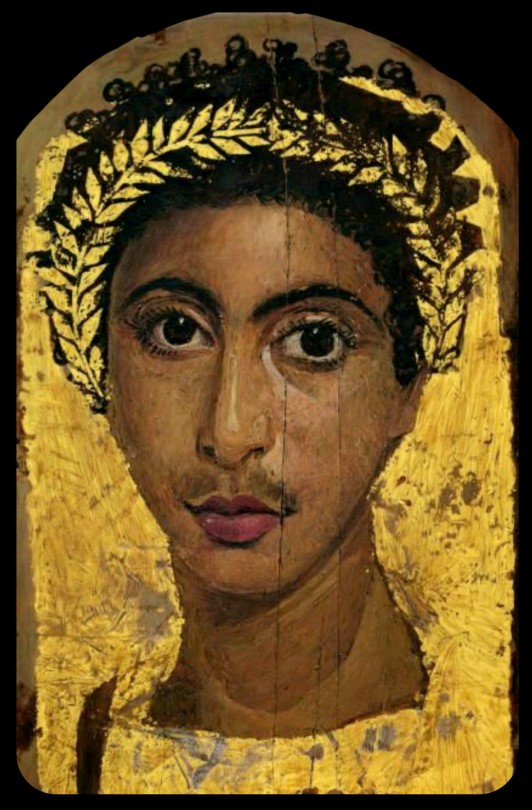
Above: portrait of a youth wearing a golden wreath, c.130-150 CE; the wreath and the background of the portrait are both gilded
The population of the Faiyum Delta, where most of these portraits were found, largely contained individuals with both native Egyptian/North African and Greek heritage. The Greek lineages can be traced back to the Ptolemaic period, when the Greeks gained control of Egypt and began to establish settlements throughout the region, gradually leading to a cultural diffusion between the Greek and Egyptian populations. The Romans eventually took control of Egypt in 31 CE, absorbing it into the Roman Empire and colonizing much of North Africa, but the demographics of the Faiyum Delta remained largely unchanged.

Above: portrait of a man with a mole on his nose, c.130-150 CE
Many of these Fayum portraits reflect the same blend of ethnic and cultural roots, depicting individuals with both Greek and native Egyptian heritage (a claim that is supported by both archaeological and genetic evidence). Some portraits may also depict native Egyptians who did not have any European ancestry, but had been integrated into Greco-Roman society.

Above: portrait of a bearded man, c.170-180 CE
These representations of native Egyptians provide us with unique insights into the actual demographics of Roman-occupied Egypt (and the ancient world at large). Non-European peoples are rarely included in depictions of the classical world; it's also interesting to see the blend of cultural elements that these portraits represent.
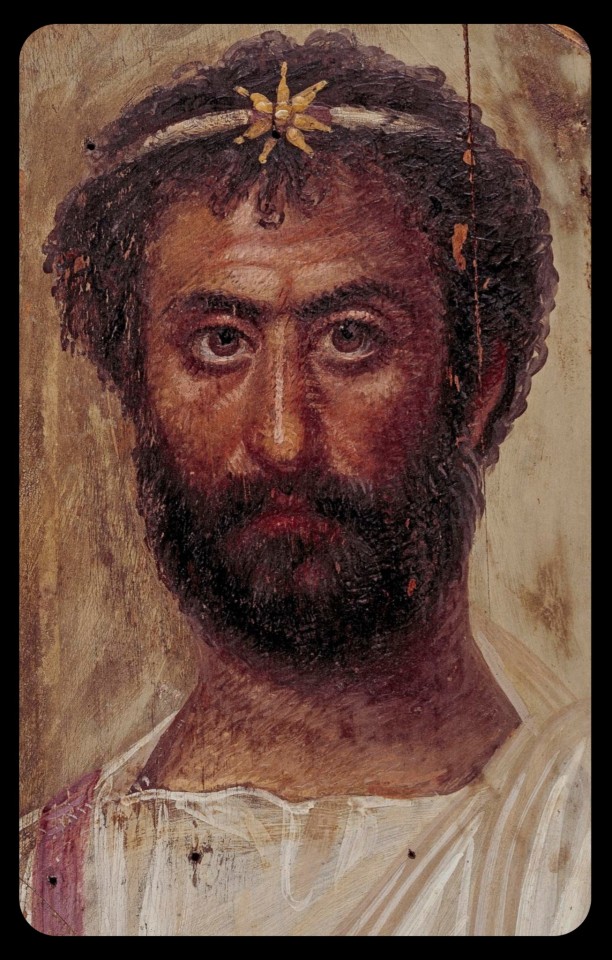
Above: portrait of a priest of Serapis, c.140-160 CE; the man in this portrait is shown wearing a fillet/crown that bears the seven-pointed star of the Greco-Egyptian god, Serapis
As this article explains:
In the 1800s and early 1900s, Western art historians didn’t know what to make of these portraits. Scholars of Roman history labeled them Egyptian. Scholars of Egyptian history labeled them Greco-Roman. These binary academic classifications failed to capture the true complexity of the ancient (or, indeed, modern) Mediterranean. In reality, Fayum portraits are a syncretic form, merging Egyptian and Greco-Roman art and funerary practices. They reflect the cosmopolitanism of both Roman and Egyptian history.

Above: portrait of a man, c.80-100 CE (left); portrait of a bearded officer, sometimes referred to as "Perseus," c.130-175 CE (right)
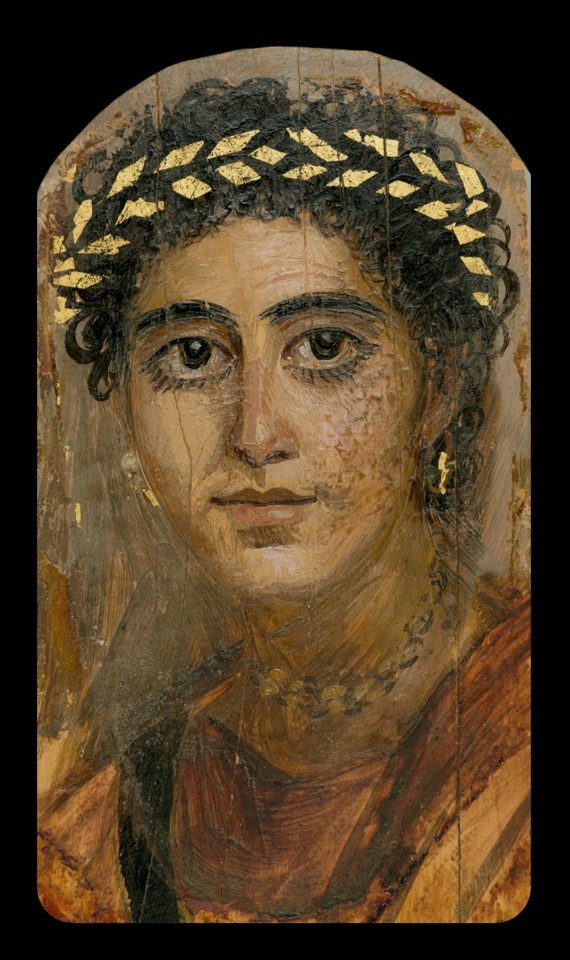
Above: portrait of a young woman in red, c.90-120 CE
Nearly 1,000 of these portraits are currently known to exist.
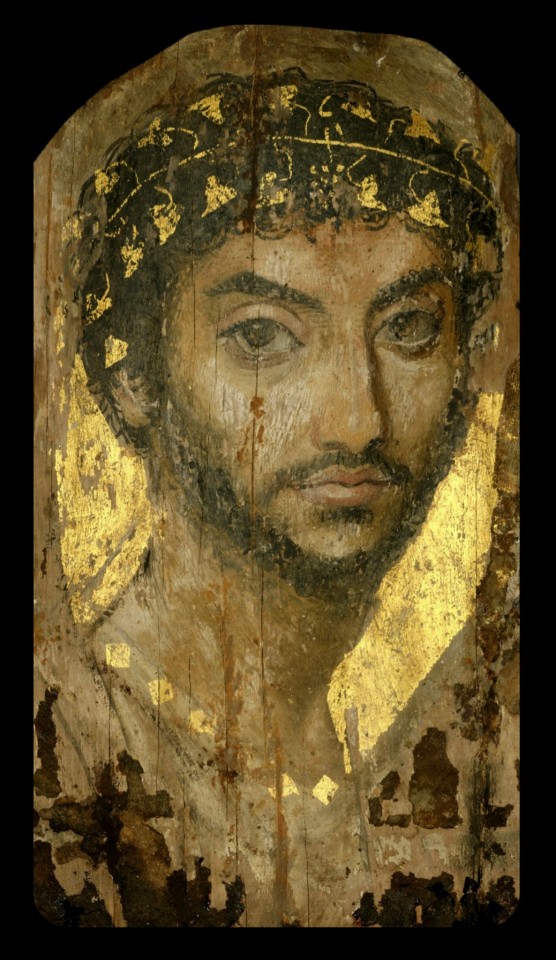
Above: portrait of a man wearing a gilded ivy wreath, c.100-150 CE
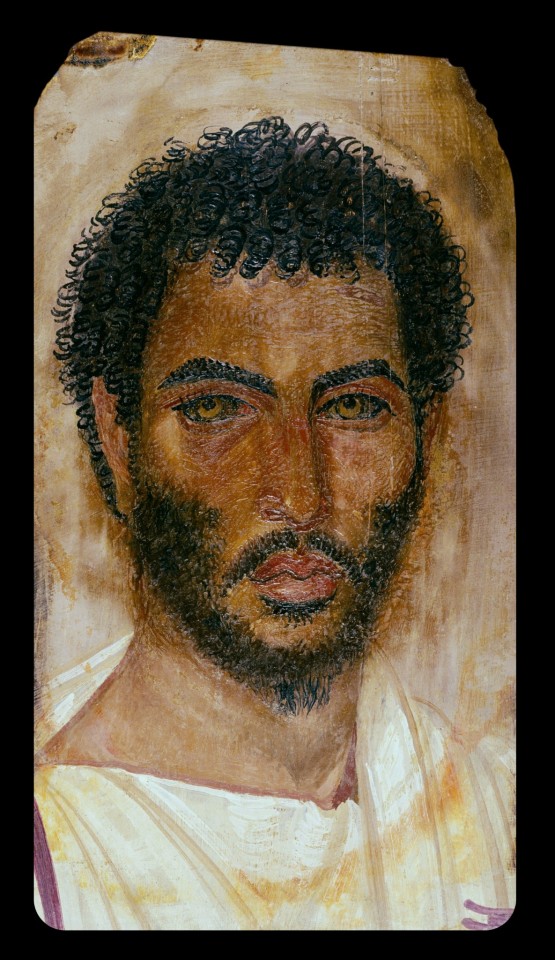
Above: portrait of a bearded man, c.150-170 CE
Sources & More Info:
Curationist: Fayum Portraits
Harvard Art Museums: Giving the Dead their Due: an Exhibition Re-Examines Funerary Portraits from Roman Egypt
Getty Museum: APPEAR Project
Getty Museum: Faces of Roman Egypt
National Geographic: Ancient Egypt's Stunning, Lifelike Mummy Portraits
The Athens Centre: The Myth of Whiteness in Classical Sculpture
Forbes: Whitewashing Ancient Statues: Whiteness, Racism and Color in the Ancient World
#archaeology#artifact#anthropology#history#ancient history#art#fayum portraits#roman egypt#ancient rome#ethnography#painting#portrait#north africa#people of color#egypt#religion#greco roman#greek#classical antiquity#fayum#mummy portraits#romano egyptian#representation
456 notes
·
View notes
Text
One thing that's been really cool about Andor is it's the first piece of mainstream star wars that really knows how to world build.
and before anyone gets upset, not everything needs to world build. the original trilogy does almost no world building. it tells you what you need to know and nothing more. we don't know what entertainment looks like, we dont know much about the food they eat, we dont know what the wealthy of the galaxy wear, aside from maybe Lando and Leia. and that's good. it wouldnt serve the story and the structure didnt have room for that kind of filler.
the prequels did a bit of world building, especially in attack of the clones. we get to see a little bit of the different lifestyles etc. so did the clones wars. but overall, the main focus is the story and the worldbuilding is just extra.
some of the star wars books and comics over the years have spent time world building, but the majority of people don't read the books.
Andor is the first piece of major star wars media to really get down into what the world looks like. The Good Morning Coruscant show, the little iPad Syril uses to skype his mom, the spiders and textile production on Ghorman, the Aldani celebration, the Ferrix funerary traditions, the Chandrilian wedding ceremony.
there's so much time spent on the details of the galaxy and i love getting to see it.
(Admittedly the Mandalorian did a little bit of world building but not nearly as much.)
#star wars#andor#star wars andor#cassian andor#bix caleen#brasso#mon mothma#chandrila#ferrix#coruscant#original trilogy
142 notes
·
View notes
Text
Ancient funerary cairn mounds in Wardi territories: a post:
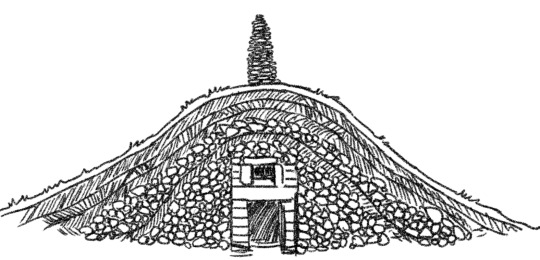
The internal structure consists of an above-ground tomb made with bricks or large stone slabs, upon which rocks are piled. Most mounds found in the lowlands also have multiple layers of dirt piled atop, resulting in the mounds becoming covered in grass and appearing as a small unnatural hill. The entrances to the tombs are always sealed with slabs or stacked stone, though the east-facing 'windows' are left open. Pillar shaped cairns were often built on their peaks, though few of these remain standing. If one looked inside, they would find a human body laid on its back with its feet towards the door, and usually at least one khait (tacked with reins and a saddle blanket) buried in there with them. The person would be fully clothed and surrounded by grave goods, sometimes carrying weapons and almost always carrying a torch.

A how a well-preserved mound looks in the present day, with its 'window' still exposed and pillar cairn intact. The stones piled around it is the work of contemporary people, intended (more as a psychological/magical barrier than a physical one) to keep livestock out and ghosts inside.
Burial mounds are associated with one the major prehistoric material cultures found across and beyond the region. Societies that formed cairn-building material culture were probably ancestral to all proto-Wardi peoples, but the practice split and existed concurrently to others as a matter of cultural shifts (most significantly the adoption of khait for highly mobile nomadic pastoralism, with other populations retaining on-foot travel or adopting settled/semi-settled subsistence methods). Khait-nomadic populations retained this cairn grave practice, while others shifted to smaller above-ground tombs located near settlements (and eventually shifted entirely to cremation). As such, cairn mounds can be found everywhere but occur most densely in open grasslands of the interior.
The cairn-building practice gradually diminished and eventually was restricted to a few major groups, some of whom abandoned khait-nomadism while retaining the practice and some of whom even traveled short distances overseas. The last two populations who built cairn graves were clustered in the Highlands and the Elumuqi island chain to the south. The latter went culturally extinct in conflict with early proto-Jazaiti migrants by 2500 years BP, while the former went extinct in the Yellowtail River Valley and northwestern ranges of the Highlands by about ~1700 years BP. Neither was a wholesale extinction of the population itself (members likely abandoned settlements and dispersed elsewheren in small groups, resulting in the final cultural extinction), but both entailed rapid depopulation, and the Highlands remained unusually sparsely inhabited compared to surrounding lowlands when proto-Finnic migrants started arriving a couple centuries later.
The most specific (though heavily mythologized) descriptions of these people in the oral record occur in Jazait and Atig Wermani cultures. In the former, the story of their settlement describes encounters with the fierce people who inhabited the islands and built the cairns. They looked like humans, but were feathered like birds and could transform into albatross to hunt for fish. They would kidnap newborn Jazait children in the night, exsanguinate them atop the cairns to feed their dead in the underworld, and would perform horrible shrieks and screams throughout the process. The early Jazait went to war with the cairn-builders and killed their clanmother, and the rest fled as birds. This story may contain traces of the real people, as the wearing of gull and albatross feathers is likely, and the shrieking Might refer to funerary wailing practices (which are ubiquitous enough among minimally connected peoples west of the Blackmane mountains to be likely Very ancient).
The ancestors of the Atig Wermani story would have encountered their neighboring cairn-builders much more recently (relatively speaking) and their accounts are a little more grounded as a result. It describes them as a people who lived in the Yellowtail River Valley, herding horses, hunting deer, and interring their dead within the cairns. The entire people was cursed by the Yellowtail river itself after their king drowned his own brother within it. The valley was flooded and most of the people drowned. Those who fled up into the hills survived, but were transformed into feydhi khait. The Highland cairn-builders are Exceptionally unlikely to have had any form of monarchy, but the other descriptions of their subsistence may be accurate, and it is almost certain that the feydhi khait landrace largely descends from this people's herds (and were found feral and re-tamed by later proto-Finnic settlers).
---
The consensus on these mounds tends to be that they are Extremely haunted. It's well-known that they're graves, and that they contain bodies that have been left to rot (and thus are assumed to contain trapped earthbound spirits, especially dangerous given their great age). Some taboos regulating behavior around the mounds are near-ubiquitous, such as belief that one should never tread over a mound, point at a mound, or look directly at its window on a moonless night (when earthbound ghosts are considered most active). It's usually difficult to prevent free-ranging livestock from walking on them to graze, and unexplained disappearances from herds are sometimes attributed to the mounds. Other taboos tend to be localized in nature, as a matter of small communities near mounds figuring out how to coexist with the dangerous ghosts.
These tombs are generally left untouched and don't frequently suffer robbery, but are sometimes broken into to exhume and cremate the body and their associated grave goods when the spirit is blamed for grave local misfortune. This is generally considered a desperate measure and very risky maneuver, as chances are very low that earthbound spirits that old can be sent onwards by even by the best of funerals.
103 notes
·
View notes
Text
Day twenty-one of “obligatory sugar baby Kon” ( no cut today, we die like Steph's tolerance for her dad's bullshit ). prev: (( chrono || non-chrono ))
He should be taking notes, Tim realizes. This is a new and unprecedented level of supervillain behavior that his fifteen-year plan can only aspire to reach.
“Asdfghjk,” he says, which is apparently actually an actual sound that an actual person can actually make, go figure. Learn something new every day.
Kon laughs at him, the fucking bastard. Tim would probably swear vengeance but unfortunately Kon looks way too damn pretty and way too damn happy doing it and is not wearing a single thing he didn't buy him and bought him a camera with his first allowance and wants to see him skateboard and has also laughed so many times tonight that Tim is starting to develop the opposite of a tolerance for it. Like, he's getting weaker and weaker to it the more exposure he gets, which is in his opinion total bullshit and totally unfair but is unfortunately still happening.
. . . well, not necessarily unfortunately, since it’s specifically happening because Kon keeps laughing and looking happy about it, but that’s besides the point. Somehow. In some way. Just–somehow.
“You’re so fuckin’ cute, babe,” Kon says, grinning at him again. He keeps doing that too. He keeps laughing, and grinning, and just–just all these things that Tim is not prepared for and honestly doesn’t even know how he could’ve been? There’s having five minutes of prep time and there’s situations that are just impossible to prepare for because how could he have fucking KNOWN. How?! How could he ever have?!?!
Literally not possible, Tim is certain.
“You’re actually incorrigible,” he says, quickly flipping his dropped board onto its wheels with a foot and then giving it a quick pop to the tail and hooking a foot underneath it to kick it up into his hand. Kon looks delighted, his eyes immediately lighting up.
“Sick!” he says. Tim felt like maybe he was getting in a win for a second there, except Kon being genuinely delighted is actually even worse and he thinks he’s just, like, kind of screwed in general now? Kon’s not supposed to be genuinely delighted by things, he’s supposed to pretend to be too cool to be impressed or just jealous that someone else is getting attention!
Tim really, really could not have ever been prepared for this.
“So like, do you know any cool tricks?” Kon asks with a wider grin, still looking way too genuine about his excitement. Tim is resigned to ruining his best non-funerary/non-gala slacks and possibly also his shirt and definitely also his dignity. His dignity is as scuffed as the shoe he just dropped his board on, and frankly that’s being optimistic.
Extremely optimistic.
“I know a couple okay ones,” Tim says, since Robin-level parkour doesn’t count as either “tricks” or anything he could show Kon, and also he’s screamingly out of practice, and also he was never really that good a skateboarder even when he had the time to do it regularly, plus skill decay is a thing and–
“That mean you’re gonna show me a trick or two, daddy?” Kon asks, grinning slyly at him.
168 notes
·
View notes
Text
MCD HEADCANON WARNING:
Sometimes... Sometimes I make myself sad thinking about Geralt dying and Jaskier selfishly keeping his medallion even though witcher funerary rites demand that a witcher’s medallion be returned to their family because he can’t handle the truth and the medallion is the only thing of Geralt he has left and you can’t make him give that up—
Jaskier never taking it off.
Jaskier wearing it under his clothes so it can touch his skin.
Jaskier holding the pendant in his hand as he falls asleep.
It wasn’t supposed to be like this. Geralt’s supposed to outlive Jaskier. Geralt’s supposed to be fine. And it wasn’t even a battle that took him out like it should have been, it was a bloody infection. And Jaskier barely made it to Brokilon forest where he’s held by the dryads to say goodbye—he walked for days on end with nothing but his clothes and his lute—and Geralt never even knew.
Geralt died before Jaskier could tell him. At least he could say goodbye to his sleeping body. At least he could see him take his last breaths.
Yennefer says Geralt knew, thinking it would help Jaskier—but that just makes it worse.
Jaskier doesn’t sing for months.
And Vesemir only knows something is wrong when Geralt doesn’t return home for the winter, and come spring, he goes to find Jaskier, knowing the bard he’s never met but heard so much about would probably know where to find Geralt.
Jaskier was supposed to be beautiful, according to Geralt. This man was a shell. And Geralt’s nowhere to be seen. And then… it hits him. And all he does is hold out his hand expectantly.
And Jaskier silently moves away, hand over his chest. His voice shakes. “No. No, you can have it when I die.”
And Vesemir can live with that. Because Geralt loved Jaskier. And Vesemir tells him as much. And from Yennefer it’s a lie to him. But from Vesemir? From Geralt’s father?
Jaskier just folds under the grief and disappointment, sinking to his knees, and starts sobbing because he could have had him. And Vesemir just stares. And for the first time in centuries, he feels the urge to cry too.
#major character death#excuse me while I sob#this is what plays every time I put on my witcher medallion#it’s a problem#the witcher#geraskier#jaskier#geralt of rivia#geralt x jaskier#geralt/jaskier#dandelion#geralt x dandelion#geralt/dandelion#geralt death#the witcher imagine
216 notes
·
View notes
Text

🇵🇸 BEFORE YOU READ: BOYCOTT TLOU • HELP TODAY • DAILY CLICK.

𝐚𝐧 𝐞𝐦𝐛𝐫𝐚𝐜𝐞 𝐨𝐟 𝐭𝐡𝐨𝐫𝐧𝐬
𝒄𝒉𝒂𝒑𝒕𝒆𝒓 𝒊𝒊: 𝒖𝒔𝒖𝒓𝒑𝒆𝒓
knight!abby x princess!reader



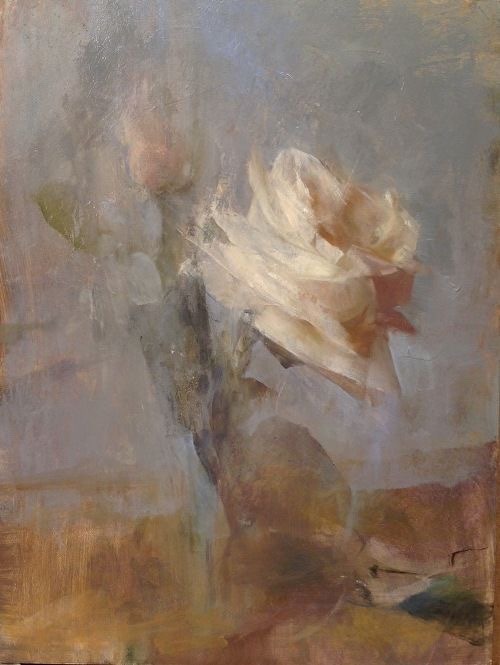

you can find chapter one here! and the series masterlist here
songs: (act one) main yeh sochkar uske dar se utha — mohammed rafi, (act two) ang laga de — aditi paul, (act three) sealed in fire and blood — ramin djawadi
summary: in the aftermath of your crime, one is eaten alive by regret and the other is consumed by vengeance. the innocence of a blooming love lies dead and from its ashes rises something raw and sweltering.
warnings: 18+ mdni, smut and angst, fingering (r!receiving), grinding (?), betrayal, typical fantasy and monarchal political themes, typical period-piece misogyny, mentions of death and a funeral, extensive descriptions of blood, violence and death, nightmares, enemies to lovers, threats made with both words and a weapon, side character deaths, profanities, derogatory language used, please read at your own discretion. semi-proofread
wc: 6.3k
a/n: sorry for the wait!! i hope y’all enjoy <3

𝐀𝐂𝐓 𝐎𝐍𝐄
The turned over soil was dark with its upheaval. The drag of earth, the thud of it, was the rhythm of a drumbeat, one that called for grief and received no answer in turn. The only ones to mourn poor Asha were the other servants. Her mother’s wails cut through the air, a skull-rattling cry of anguish. The others did not allow themselves to weep. The workers of the Palace had seen enough bloodshed within its cold, white walls, now numbed to its horrors. Only exhaustion engulfed their features. Another one…
Asha understood this pain as much as she did the thump of her own heartbeat. That was why she decided to work with you, to be a gatherer of secrets. You could still remember the lightheartedness that graced her features, her lopsided smile when she said, whose eyes are all-seeing if not a maid’s?
You were the reason for this girl’s demise. It may have been that nobleman’s blade that sliced to the bone, but it was your promises of hope and security that led her to an untimely grave.
You, a coward. You, a murderer.
You slipped back into the Palace as the rosy shades of dawn swaddled the figures of the grieving, before the welling of tears threatened to fall. Your weeping would have been a mockery, something disingenuous to those who would bear witness. Did you have the right to wear mourning white and feel emotions strong as the beating sun, throat dry and body weak?
Another face flittered into the forefront of your mind, freckled and sharp-lined. Grief clung to the inside of your ribcage. If only you could crack it open and pour this ugliness of yourself out, become pure and benign. Become something worthy of any of the graces you had been given.
You could taste bitter salt on your tongue, feel warmth drip from nose to lip to chin. You could pray and cleanse yourself of your sins all you liked, but it would never be enough. She would look upon your heart with fondness no longer. She saw you as you were, now. Treacherous, rotten, worm-eaten.
☾𖤓
You still adorned funerary attire when you arrived at the Palace’s holding cells. It was located deep within its bowels, lacking its upper cleanliness. The bricks here were haphazardly laid, and an oppressive dampness had seeped itself into each nook and cranny of the place.
The guards had sputtered at your presence, choked words of you not being allowed down here falling from their lips in a weak attempt to deny you entry. But you knew them well. Their loyalties lay at the feet of the Crown’s coin, not at the throne of the King. All you needed to do was shove a necklace and a few bangles their way, and their lips were sealed.
The soft leather of your soles caught slightly with each step, made for marble floors and not the rough and dusty ground beneath. The only sounds present were that of your jewellery chiming with each step and a distant drip, drip, drip.
There were no other prisoners within the holding cells, long since shipped off and never to be heard from again. Icy tendrils ran up the length of your spine as you made your way down the cramped hallway, eyes frantically searching.
She was in the cell at the end. Her back was turned, silhouetted from the little light that encompassed the space. Her outline looked equally defeated and taut, as if she was grappling with what was and what should have been.
You stepped closer, an exhale forcing its way past your trembling lips.
”Abigail.” Relief tapered the ragged edges of your voice. Your intricately stained hands clasped around the rusted metal of the bars as your entire being lurched forward.
Her body snapped tense, bowstring-tight, the set of her shoulders alone divulging the bitterness that simmered just beneath the surface. There was a moment of palpability as you let your presence hang over her, as unwelcome as pelting rain.
”Abigail,” you said more urgently when she remained unfacing. Softer, “Look at me, please.”
At your coaxing plea, she turned her head to the side. Her familiar profile was illuminated by the weak, flickering flame upon the wall. The sight of her was faint, but there was a certain fatigue about the set of her brow, something restrained in the pinch of her lips.
”You...” The word was pushed out on a weak breath, hazy as if pulled forth from a dream. Then, she gathered her bearings, shoulders rolling back and straightening so her broad frame swallowed up more space. Acrid venom coated her vocal chords as she squeezed the word, again, through the grit of teeth. “You.”
“What are you doing here?”
You crouched to your knees with the hesitance of somebody trapped at the whims of a beast. Her sclera shimmered violently in what little light there was. Those eyes had always been a weapon against your resolve. Each glance of hers was a nocked arrow aimed at the fortified centre of your heart. Now, it was as if she had dipped the arrowheads in oil and set them ablaze.
Your voice tumbled, an unfamiliar bubble of uncertainty rising within it. Carefully chosen, sweet words would not work on Abigail. You were disarmed by her, at the mercy of your own foulness that had been laid so bare before her.
So instead you decided to speak a truth, one that would not gut either of you so quickly. “Asha, my… the handmaid. She’s dead. She was killed by that nobleman.”
You waited for a response but Abigail remained silent, eyes pinning you in place and searching for any sign of trickery. Your fingers tightened around the bars as you stared back, seeking any crack that she bore, any fissure you could slip through and work to your will, but none sifted to her stony surface. Perhaps she just relished in watching you squirm.
“Her burial was this morning,” you spoke gently, the image of the lively girl flickering across your mind, seared there forevermore. “I came here immediately after. I knew that— I was overcome with an urgency to see you.”
Her eyes drifted to your white clothing. A hateful, bitter smile split the plaster of her features.
“Will you blame that poor girl’s death on me as well?” she asked in a mocking tone, voice laced with amused contempt. “Oh, I can hear it now, what they will say about me. Abigail, so faithful a knight that she struck down feeble noblemen and maids alike for her princess.”
Heat crept up your neck as you bristled at her mockery. There it was, the stinging lash of the truth coming to strike once more.
“If I recall correctly, you were the one who took the fall for the crime. This is on you, Abigail, and your own foolishness. You have… you have no right to scorn me for it.”
Her body dipped forward, closer, and it was the first time you heard the weighty rattle of chains. They were fastened onto her ankles. Normal conduct for an alleged killer, yet they looked so misplaced now. Such a far cry from the shining knight she was only days ago.
The derisive tone she had moments ago slipped away to reveal a nakedness, a rubbed-raw thing that clawed its impatient fingers up her aching gullet. “And you did not fess up to your crime. You watched like a helpless little lamb as they dragged me away, all the while you were bathed in that man’s blood.”
Her voice shook with the vulnerability of leaves caught within a storm, but it was not tears that she tried to reign back. It was rage, pure and sharp as the edge of a diamond.
“Where is your honour, princess?!”
The same dormant fury that she held close to her sparked to life in your chest. If it were anybody else, you would have shoved the vile emotion down, but it was her. She had already seen the violence, the pulsing and ever-malleable wrath, that consumed your entire being. For once, you could be outwardly wretched. You could be honest.
Honour this and honour that. The blood of a hundred monarchs shaped the very drum of your heartbeat and she wished to speak of honour? You would laugh if it weren’t for the tightening fist around your lungs.
The colour seeped from your knuckles as you pressed yourself closer to the iron bars, as if you could melt into them with the very ferocity racing within you. “You forget yourself,” you reprimanded firmly. “If you dare question my honour again I’ll—”
“What will you do?” Her chin jutted out, mouth pressed into a thin, stubborn line. The possibility of challenge hardened her features. “My title has been stripped, my morality brought into question– all on the basis of a lie. There is no worse pain that you can inflict upon me.”
Yet your life remains intact, you thought viscously. Yet I let you sit here and lick your bloody wounds, unharmed.
“You should know my capabilities well by now,” you whispered, your words drifting to her like opiate smoke; low, heady, perilous. You were not subtle in the ribbon of a threat you wrapped around your words, tightened noose-like in the way your eyes pinned her in turn.
She rose to her feet then, the clank of iron ringing in the air as she dragged herself closer to the bars. She stopped just out of arm’s breadth from it as the chains screeched in protest.
You had never felt threatened by her presence, but now you could at last understand the notoriety of her legacy that followed her like a shadow. As she looked down her nose at you, you felt a dull pang of sympathy for the long list of her opponents on the battlefield. Even restrained, she was a formidable sight.
“And you remain ignorant of mine…” she spoke lightly despite all things. “You would do well to remember them, princess.”
There was a pointed promise in the way her lips shaped around each word, as if each one was loaded with the very essence of vengeance.
You lifted yourself from the ground, elegant as ever as you straightened your back and met her eye, drawing the veil that had slipped onto your shoulders over your hair once more. A princess. Her superior.
A smile curled on your lips, the cloying quality of milk beginning to sour. “We shall see, then, how… proficient you are from within a cell.”
Your head dipped forward slightly, a hand pressed to your left breast. There was a taunt in how respectful the gesture was. It was one only exchanged between equals.
“May the gods smile upon your determined spirit, Abigail.”
𖥸 𖥸 𖥸
𝐀𝐂𝐓 𝐓𝐖𝐎
You were dreaming of it again. Metal in your hands, metal in a gut. The bubbling groan of a man mere moments away from death. And, oh, the crimson, everything red-slickened and raw. His eyes were no longer his own, but rather beads of boundless contempt, staring and staring and—
Reality slammed its fists into your chest, awakened with a choked gasp squeezing its way out of your throat. Your eyelids flew open to the deep blue near-dawn. The crooning of first birdsong flitted through the arched doorway, eerie in its solitary note. You blinked up at the roof, the carvings of deities and flowers shifting and mingling, one and the same, in your unfocused vision.
The man you killed was not owed any sympathy. He was egotistic and wished to be as close to your brother as a cat curled on its owner’s lap. He would have done anything to garner the love of a tyrant, and you felt a nauseating amount of hatred for him even in his demise. There was no remorse for killing him, and you reminded yourself that it was an act of rooting out bad weeds before your reign, but your subconscious disagreed.
It was still taking a life and it was a defiling rake of nails beneath your skin. No matter who the man was, he was still human.
You wanted to be ruthless, to cleanse yourself of any feeling and barrel towards your goals with cold, uncaring resolve. But then you would be the spitting image of your brother. The thought of it made your stomach turn.
You sat up then, the sheets slipping off of your torso and heaping onto your lap. You dragged your shaky hands down your face until your fingers traced the soft outline of your lips.
Your thoughts parted then drifted back to Abigail. At this hour, they seldom didn’t
You recalled the strength in each of her actions even as she moved about with an easy fluidity. The glimpses of raised white scars that littered her body, one that you had never known the complete bareness of.
What were her feelings when she first killed someone? Was she now plagued by a thousand phantoms in the world of her dreams, still bleeding from the wounds she inflicted upon them? Did she feel nothing at all?
Your rumination was cut short when a faint breeze wafted through the curtains, fragrant from the foliage below. You lifted your head to it as it stirred the loose hair that brushed against your forehead. The action should have been soothing, but what you spotted turned the blood in your veins glacial.
You had no idea how long Abigail had been here. She was sitting on top of a floor cushion in front of the balcony doorway, one knee propped just beneath her chin and the other leg stretched outwards. The position would have looked regal, akin to the uncaring languidness of a ruler, if not for the way she watched you. Chin pointed towards her chest, a blue glare slicing through long brown lashes.
She was motionless in the purpling hues of morning, more beast crouched in wait than leisurely empress.
The fear you felt seeped marrow-deep, but something else lurked beneath it. swirling in the pit of your gut. It had been months since you had seen this face last, yet it was stitched into the seams of your every thought, conscious or dreaming.
Something within you lurched.
For once, words eluded you. Ambition was a potent drug, you knew, and paired with vengeance it became absolute. How could you placate such a resolute mind?
Your throat dried as you watched her stand. There was no preamble as she crossed the room in a few long strides. This time, there were no chains and bars to keep her sequestered. The truth of this should have sent you scrambling, but astonishment buoyed you to the bed, quiet.
Her freckled cheeks were awash with a rosy red, almost cherubic despite the face that she wore. A hateful expression. A hate so powerful, it teetered on a look of pain.
Your thumb twitched as she stopped mere inches away, the desire to smooth out the uneasy crease of mouth and brow shoved back into the depths of yourself. Why did her presence, the mere concept of her, steal away all reason and substitute it with something so sickly vulnerable?
You opened your mouth to speak, but the words wilted on your tongue when you felt the cool press of steel against your neck. There was no tremble in the blade. Her grip on the hilt was certain.
Understanding came as steadfast as the morning unfurling itself to the earth beyond your chambers. You, lovesick. Her, loathing you for it. For all of it.
“If you utter a single word…” she warned through gritted teeth, pressing the tip of the blade closer to your skin, the pressure of its presence imminent.
Her eyes drifted down to the column of your throat, eyeing the stable heaving of your chest. A scowl fractured her features. “I should end your vicious little life right here and live up to the title you've cursed me with.”
You could sense it, the unspoken however. The wraith of the word settled over you like the gauze of a veil. If she wished to kill you so badly, she could have left you gutted on the fine sheets and fled before buttery sunlight engulfed the room.
Why hadn’t she?
“I expected the same amount of goodness in response to my sacrifice. I expected you to come clean or… or to at the very least free me from that miserable cell!” Her features contorted at the remembrance of the dark, cramped space, the stifling silence, the numbing solitude.
Then, the more chilling memories. Your face, flitting behind each blink. Your laugh, heard in the heavy rhythm of her own breath. Your lips, whispers and kisses and bites, felt only in the slumbering hours of a place that remained in stasis. Her hand flexed around the weapon.
Her voice took on the timbre of fervently plucked sitar strings. “The very thing I pledged my life to, the very thing I killed for, left me to rot. My King and his supposed sweet, saintly sister… how do you think such a wound festers, princess?”
You could not dignify her question with an answer. You had known no such discomfort, no such betrayal or ache.
“Abigail…” Her name, spoken again with the quiet of a clandestine prayer. What else was there to do but acknowledge her through these three sweet syllables?
A prick of pain. The warmth of lifeblood trickling down the length of your throat. Just a nick, a rivulet. Abigail drew in her breath. Her irises seemed to shiver in their anger.
“I told you to be silent,” her voice sank into an exacerbated whisper. “Or would you rather I skewer you now?”
Gone was the radiant, gentle-hearted knight, eclipsed by the moon of this new vindictive creature. You were enraptured by the jaggedness of her being. Hair uncharacteristically dishevelled and loose around her shoulders. Dilapidated sleeves rolled up to the elbow.
“How angry you are…”
“Insolent–”
“Your beauty shines like this.”
Silence, thick and saccharine as flowing honey, settled over the moment.
Abigail looked as if you had snatched the dagger from her and plunged it bone-deep. The first tremors of uncertainty twitched beneath her sure, calloused fingers.
The wanting, besotted thing within Abigail gnashed its craving teeth. No. She would not let you disarm her of this, the one vein of conviction that pumped purpose into her battered heart. I will not waver.
But it was another thing entirely, to resist the beckoning call of surrender when you reached for her.
The moment your sleep-warmed hands came in contact with her own, she knew that fighting was futile. Her grip loosened, the blade slid from between her palms and into your own grasp.
It was without a doubt stolen. It was weighty and intricately engraved with motifs of the sun and moon. The crest of your kingdom. How ironic.
Your gaze flickered from it to Abigail, whose eyes chased every movement of yours. She was waiting for you to return the favour, to press the blade to her own throat.
It never came.
The blade was placed on the low, wooden bedside next to the bed, its mass clattering against the varnished surface. Surrender.
“Why…?” she breathed through the constriction of her lungs. Where was the familiar fire, that arrogance she came to despise?
“We were not destined to be adversaries.” Spoken as if this rivalry was something you alone could decide.
Your features were aglow as first rays of dawn crept its way into the room. Brilliant eyes, straight spine, parted lips. In the liquid, shifting gold, you looked incorporeal. Coaxed from the most bereft parts of her mind.
A large palm cupped the softness of your cheek, a thumb running over the bending bone of your jaw and leading up to the bridge of your nose. She had to remind herself, sometimes, that you were flesh and bone beneath the title and crown.
They say that the royal blood carried on the legacy of a fallen deity, who perished for nourishing this very kingdom. She never considered herself a particularly pious person but it rang true to her, especially now.
“Then, enlighten me, princess,” she spoke softly. “What path have the gods carved for us?”
“The gods have no hand in this.” Blasphemous words that cut into her. “No, I won’t accredit this to divinity.”
Your eyes fluttered shut, and you let yourself melt into the coolness of her touch. “I want you, Abigail.”
A litany of pleas that danced, unsaid, on your tongue. Love me, love me, love me.
Begging was unnecessary, for the same thrill of need sang in her own bones. She tilted your head up slowly, admiring the way grandiosity slipped from your being as swiftly as it came.
Her lips against yours were a beckoning. They moved with a sure rhythm, gentler than the last time. Her kiss told you to unveil yourself to her. Give me sincerity, it whined. Give me an honest place to lay this love.
You fell back against the plush pillows, pulling her down with you. Her weight crashed against yours, hefty and unknown, yet comforting in its corporeality. She smelled faintly of mildew and rain, a scent splintered with the sharp tang of rust.
Your tongue ran across the bottom of her plump lip gently, asking for entrance. If she wanted the truth, you would offer it in its entirety.
Your searching fingers found her blonde tresses while hers skimmed down to the hem of your nightgown. She slowly drew the airy fabric upwards from your ankles to your knees and then the middle of your thighs. The contact of the calloused drag of skin sparked something within, warmth coiling in the pit of your belly like a slumbering dragon.
You broke away from her to sit up, pulling the piece of thin cloth up and over your head. Abigail watched, sitting back on her haunches, as each inch of your skin was bared to her patient gaze. The softness found in each curve was a marvel to her, a body unmarred by the outside world. She observed you like one would an intricate tapestry, each whorl and knot revealing more depth with each second passed.
A hum of appreciation reverberated through her chest as she began to focus on discarding her own threadbare clothing. First, the tunic and then the tight hose that stuck to her skin.
Her body was a thing conjured from epic poems and scriptures. Robust and sunkissed, with the new dawn melting over her back and haloing the outline of her body. A hero, draped in the splendour of victory… a god, blessing the mortal realm with its incomprehensible presence.
You reeled Abigail back towards you, the searing heat of her heaving chest pressing against yours. Her lips trailed dulcet kisses along your jaw as her fingers splayed against the flesh of your thighs.
Your bodies melded together, pressing as if through the sheer force of passion, you could become one. Your bodies sang with pleasure, thrumming out an ancient and gasping melody.
Hands and eyes, dilated with velvet-black pits of ecstasy, explored. You traced over the scars that ran down her body, transforming them into rivers and pathways, her body an entire world that they occupied.
Her fingers grazed over the wet, sensitive flesh between your legs, silky and petal-like. They found the sensitive bud there, rubbing gentle circles upon it with her thumb while two of her other digits prodded for entry.
You arched into her, a sweet noise dancing off of your parted lips as she slid them in knuckle-deep. She lured bliss from your body with each thrust and curl, each sweet word and absentminded, drunken press of her lips against yours.
Your writhing figure against hers was enough to make her own cunt throb with pure need. You felt, even through the haziness, her broad body rocking against yours, her pelvis gently seeking friction against the plushness of your thigh.
A symphonic crescendo of moans swelled in the morning air as you both neared shivery climax. Her ministrations grew more frenzied, eyebrows knitted together and bottom lip drawn tightly between her teeth.
The pressure snapped, swift and blinding. You held onto Abigail tightly as she shook along with you, shallow breaths mingling together. The hard planes of her stomach were now sweat-slicked and she felt almost feverish against you.
As the throes of orgasm subsided, you raked a hand through her hair and pressed a dry kiss to the junction between her neck and shoulder. She was still panting, slumped on top of you.
This was a first, this contentment that wound itself through her being. There was not an ounce of tension in the sculpted divots and muscle.
You pressed another kiss to her temple and you exhaled as she buried her nose further into your collarbone.
Vulnerability rose up within you, and this time you loosened your grip on its reigns. Insatiability had always been your greatest weakness. You wanted her, you realised, not just in passing but always. You wanted to wake up to golden hair fanned across your pillows and a freckled nose pressed up against yours. You wanted the surety she guaranteed and the devotion that it promised.
You wanted to love with all of yourself, and not just through the confines of the mould that you had been trapped in since birth. You wanted to be loved, no matter how many times you were forced to bloody your hands.
For that, however, you would have to peel back one last layer.
☾𖤓
Abigail was turned away from you as you told her your plans of usurpation, her face tilted up towards the heat beating in as she gathered up her scattered clothing. She pulled each piece on with a languidness, the nape of her neck still flushed beneath curling blonde baby hairs.
The lack of reaction turned the sweetness of your post-lovemaking haze sour. Your thoughts raced and tangled together in an incessant bundle as you forced the words leaving your mouth to remain a steady stream.
Would this revelation swing the pendulum of rivalry into motion once more? With your prior actions, you could sympathise, but this… this was grander than her. It was the ember that would flare the kindlings of hope; a prosperous future assured.
No remorse could be felt for that.
“Abigail…” you spoke slowly, the shape of her name dripping with solemnity. “My conviction is stone.”
You drew breath into your lungs as you watched her drag her bottoms up her legs, as if you were whispering sweet nothings and not outright treason.
“If you are not my ally… if your heart's not in this, I will declare you my enemy.”
You touched the dagger still resting at your bedside, precious and half-forgotten. “Do we have an understanding?”
She turned to face you then, absentmindedly fastening the ties of her tunic. Tousled but bright as noonday, she was beautiful enough to crush the new bloom nestled in your heart.
She gazed at the weapon before looking at you directly. Clear blue and milky white, unwavering and unreadable.
Not so much an arrow now, her eyes were a roaring blaze, and your resolve was the aftermath of something swallowed whole.
𖥸 𖥸 𖥸
𝐀𝐂𝐓 𝐓𝐇𝐑𝐄𝐄
The wind wailed into the silence, crashing its invisible body against the looming Palace and whistling in the gaps of the sun bleached stone. Chaos roiled in the underbelly of the night, the closing notes of summer felt in the lashing heat that lingered.
Despite the late hour, the oil lamps in the throne room and surrounding hallways burned low and perilous. Servants scurried out of the way, prostrating themselves on the ground as a cloud of white and gold glided past them.
The tremendous, ancient doors opened with a loud groan, making you swivel around. Encased in the rigid formation, like an egg warmed by a hen, was your brother. He spared you so much as a glance as he climbed up the stairs leading to the throne, his footfalls muffled by the plush, richly coloured carpet. The knights dispersed to their positions as he did so, silent and armed witnesses.
“My King…” You knelt low to the ground, your head centimetres from the cold marble. You were his subject first, his blood second.
You heard the rustle of fabric and the sigh of a feather-stuffed cushion being squashed beneath weight.
“Rise.” His voice was clear and authoritative. You lifted your head to your mirror. The same eyes beneath a cruel set of brows. Same mouth, pressed into a thin line. The same hands, enclosed around the sheath of a sword, merely ornamental. A dutifully polished thing that had never tasted violence.
You stumbled onto your feet, and noted his clothing; a plum-coloured robe and a necklace of pearls and rubies dripping down his throat, like bone and blood congealed. Ever opulent, ever the lavish King, even in the privacy of nightfall.
“State your business,” he spoke with a now bored inflection. “Tell me why you have disturbed me at so late an hour.”
There was a hum of warning beneath his tone. If the reason for this disruption was frivolous, you knew he would not think twice about spearing you through.
After all, what was an imperial daughter? Your value was held in your capability to be married off, to secure alliances, to fawn and charm and pamper. You had proven long ago that you would not be a bargaining chip in the game of monstrous men.
You may have been worthless in that regard, but perhaps there was a way to regain his favour…
Eyes wide and lips quivering, you huddled your arms to your chest. Weak, small, inferior tohim in every way.
“I caught her, Your Grace. The knight that escaped her cell,” you spoke through the warbling tones of fear. “She… she made an attempt on my life, but, blessed by the gods, I was saved.”
This piqued his interest. Your brother rested his chin on a thickly jewelled hand, his body leaning forward. Frankly, there was no love in his heart for the nobleman that lost his life, nor was there a thirst for vengeance because of it. Nonetheless, Abigail’s escape had tarnished his punitive, unbested reputation.
For that alone, her head deserved to roll.
“Ah… finally a useful word you speak.” He smiled, his lips still wrapped around his teeth. Its mirthfulness stopped short of his eyes, still as shrewd as ever.
You watched as he gestured around the room, turning his head this way and that in mock confusion. “Well? Where is the unloyal cunt?” Joy trickled down into his demeanour now and, like a child anticipating gifts, his body straightened and his eyes shone. Only in his cruelty did the more human parts of himself show from within.
You turned to the guard standing beside the entrance, and inclined your head deeply.
There was a whirl of feather-white silk as he left the throne room, and mere moments later, the clang of metal against the marble floors reverberated through the vast space. It was different from the cheerful, jingling song of the anklet bells of dancers that typically graced these halls. This was weightier. It held no rhythm or reason.
Abigail was dragged in hastily, adorned from waist-to-toe in chains. The men who pulled her along dumped her onto the ground unceremoniously and her form sprawled with no resistance. The dry scratch of her voice, pain, left her lips. Her golden, knotted hair clashed with the deep red of the carpet, spilling across it as she tried to right herself. It was one last shred of dignity, to rise upon trembling knees.
A low, appreciative whistle shot through the air, drawing your attention back to your brother. A grin now split his features, a thing with too many teeth. Each gemstone shimmered as he stood, a wave of light as he clutched his sword tightly by his side.
“You’ve done well, sister,” he praised as he descended the stairs slowly. His eyes were trained on Abigail as he spoke to you, his steps were punctuated with the chime of finery. He had a likeness to a predator in this moment, something feline slinking towards its prey.
“Very well, indeed.” Deep purple pooled at his ankles, his finely crafted shoes just centimetres from Abigail’s form. He looked down his nose at her, undeterred by the glare she shot up at him.
There was a hiss of steel being drawn. Your brother’s sword was an elegant thing passed down to the new King when the old died. Golden hilt and flowering carvings that twined up the blade, it gleamed prettily in the lamp light. Despite its deadly point, it had never been used for battle, only a symbolic cementation of status.
What was he…
He tossed the sheath away and its impact rang hollow across the cavernous room. Then he turned away from Abigail, his attention on you.
Instead of blinding pain, you were met with the handle being held towards you. His eyebrows softened, you supposed, in an act of what he believed was familial fondness. If I cannot exploit you as a flower, I will make use of your thorns.
“I believe this victory is yours.”
You had no choice but to take the sword in shaking hands. The surprisingly lightweight hilt felt like fire, burning in your grasp. In all your years, you had only ever gazed upon this ancient relic.
Your brother rested a hand on your shoulder, as if to soothe your nerves. You were a skittish animal, always, in his mind.
“Even a fool can do this if the blade is sharp enough,” he whispered, lullaby-soft. “Get your vengeance, my sweet sister. Honour our blood and let the final image of her life be the throne that she betrayed.”
Your fingers pressed into the cool metal. Abigail’s eyes were trained on you, her mouth parted ever so slightly. You watched as her body shifted. Lungs expanding, throat constricting.
“Now!”
In an instant, disarray seized the room. The clang of armoured bodies sounded everywhere and so too, the squelch and roar of men dying. The resounding whine of the doors being closed and barred. Trapped in the midst of massacre.
You kept your gaze trained on your brother’s face. First, you watched as he recoiled with shock. The curtain-lift of realisation.
Finally, anger.
The hand on your shoulder tightened and bunched the fabric of your nightgown. His teeth were bared and the veins in his throat protruded with rage.
“What have you done?! You spineless little bitch!”
Your brother was wrenched away from you with full force, curses and spittle still flying from his mouth as he was forced onto his knees. Abigail was out of her chains, never completely restrained to begin with, and she eyed you with a tight expression as she held him down.
“What have I done, brother?” Your voice now trembled with the venom of restraint snapping. “I have done what is right. Our people deserve a true ruler, not a coddled man who plays at one.”
A wet laugh bubbled from his mouth, hysteric over the symphony of steel around you. “And you think you have what it takes to be a ruler?” His eyes were open, drinking in the light, wide pools of disdain. “If I am so coddled, what does that make you? Tell me, what do you know of history? Of warfare?
“What are you but a woman? You were raised for marriage,” he continued, his amused mask slipping to reveal the undercurrents of fear that roared within him. “I was raised to be King! This is my birthright and you cannot simply snatch it away!”
“Princess.” Abigail’s voice was stern over your brother’s prattling. A simple reminder.
You stepped closer and watched as he faltered.
“W… Wait and heed my words. There is an order to these things,” he spoke desperately. “Disposing of me won’t alter it. Do you think the masses will warm up to you just because you are soft-hearted? They will still starve and slave their lives away, and they will hate you all the more for your gentleness. See things as I do, sister. When their hunger grows, will they look upon you kindly? You struggle, even now, to hold a sword.
“They won’t view your weakness as benignity.”
Even in the act of begging for his life, he managed to crush you beneath him, like wilted petals in the palm of an enclosed fist. You brought the blade close to your face and inspected each silver bud of jasmine and rose.
“Should I care about whether they view me as strong?” you asked, the cadence of your voice sounding distant and foreign to your own ears. “You forget that within the hour, I will control your army.”
You held out the sword in front of you then, the steel glinting. Your ancestors were right not to use it. It felt like a sin to have to dirty it.
No matter, you supposed. Today, history will be rewritten. With its rebirth, it was inevitable that some traditions would rot. Best to start with this one.
“What was it you told me before? ‘If the blade is sharp enough…’”
The wailing of a man defeated pierced your ears. His eyes were unseeing and yet so filled with despair. He slumped against Abigail’s grip and she let him fall to the ground with a thud.
You loomed over your brother, sword raised over your head.
“Goodbye, dear brother. We will meet again, I’m sure, in the land of the damned.”
It was as clean as the business of death could be. A splash of vermillion against the desolate white. A whimper, followed by cloying silence.
The deed was done.
#gold star reward if u spot the princess mononoke reference#knight!abby#abby anderson x reader#abby anderson x you#abby anderson angst#abby anderson smut#abby anderson#abby tlou#abby the last of us#tlou writing#tlou fanfiction#abby anderson fanfic#tlou2#tlou#the last of us#aeot
143 notes
·
View notes
Text
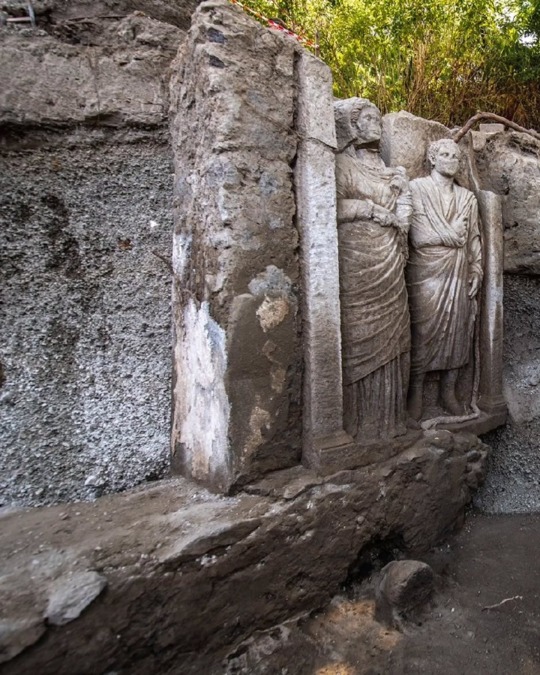


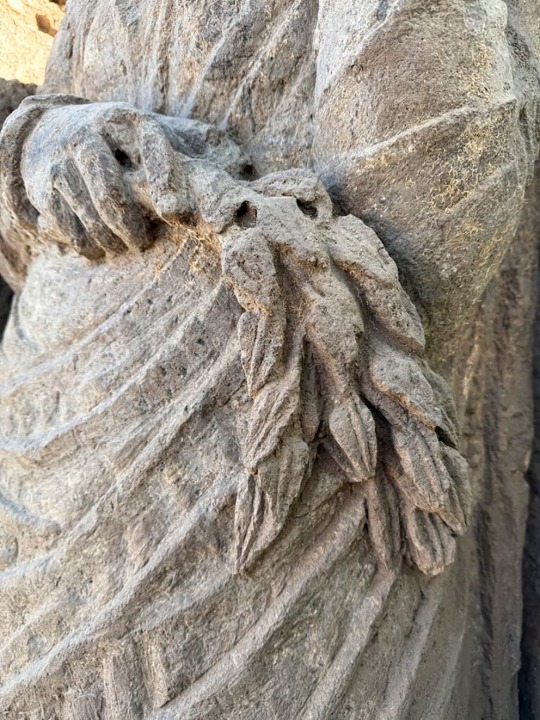
In the Porta Sarno necropolis, east of ancient Pompeii, a large funerary relief has been discovered with figures of a man and a woman sculpted almost life-size. It is believed they may have been married, as the monument lacks inscriptions, making it difficult to determine the relationship between the two.
Based on its stylistic characteristics, it has been dated between the 2nd century BC and 27 BC.
As details, the woman wears a tunic and cloak, appears veiled, and wears a lunula or moon-shaped pendant, as well as earrings, rings, and a bracelet. In her hand, she holds a bunch of bay leaves associated with purification rituals in Roman cults. The woman may be a priestess of the cult of Ceres, the Roman goddess of agriculture, harvests, and fertility.
The more sober male representation wears a toga.
Information.
Pompeii Parco Archeologico
(Photos©️Alfio Giannotti)
75 notes
·
View notes
Text
so, about that death certificate
OR: Revek is a hater for too many words straight. Sorry about the negativity. This is technically a continuation post from the two I made [1] [2] about Jason's death.

This is Jason Todd's death certificate. We've all seen it. As far as I can tell it's from The Batman Files, a book of sorts that compiles in-universe documents--"Bruce Wayne's secret journal."
This fucking thing sucks. And I HATE it and it's WRONG. The information in it blatantly contradicts canon, and on occasion even blatantly contradicts the cover-ups in canon. Let's break it down:
Dying "in Bristol County and the City of Gotham"
No he didn't
No, he didn't, not even in the cover-up version of events
As we all know Jason died in Ethiopia (or Qurac, or Bosnia, depending on adaption or comic continuity). He does not die in Gotham unless we're digging into deeply removed elseworlds like the HBO's Titans (2018).
Within post-crisis (which is where we're living, given that the publication date for The Batman Files) Bruce literally tells Ethiopian authorities that the kid who died in the rubble was Jason Todd.

Bruce is basically pretending Jason died in an accident here. An accident in Ethiopia, not Gotham. Getting Jason a death certificate from Gotham in general is just??? Wrong??????
Aside: Bruce should probably be concerned about the Joker potentially making the connection between the Robin he beat and blew up in a warehouse in Ethiopia with the Famous Gotham Billionaire Bruce Wayne's adopted son Jason Todd blowing up in a warehouse in Ethiopia. But Batman also later beats up the Joker while screaming Jason's full name at him, so... secret identities who?
Jason Todd's height and weight
The numbers (4'6" and 87 lbs) are pulled directly from one of his character info pages from the 80's. Namely, one written when he was still alive. When he was... you know, still growing. Yes he was 4'6" at some point in his life, which most of us were!! That doesn't mean he's that small when he died.
On the other info sheets, he's 5'2" and 105 lbs (pre-crisis) and 5'0" and 110 lbs (post-death). In The New Titans #55, his height is listed as 5'4".
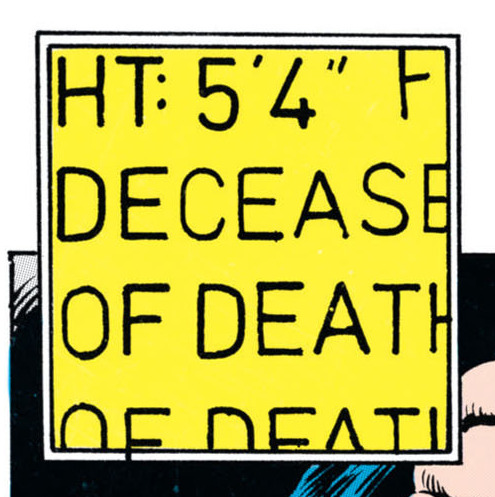
Yes, other sources about Jason's height are inconsistent! There isn't a right answer but 4'6" is pretty clearly a wrong one.
Tangent about I, MORTIMER GUNT, City Coroner
Mortimer Gunt is apparently an actual guy in the DC universe. His job is listed as mortician. MORTICIANS ARE NOT CORONERS. Why is he listed as City Coroner!!! Coroners are elected officials who determine cause of death, morticians are the ones that prepare funerary arrangements.
(Coroners also do not need to have a degree, are distinct from medical examiners/forensic pathologists, and there's many an anecdote out there of coroners fueling conspiracy theories and helping cops by providing inaccurate information about cause of death, but that's a discussion for another time.)
"Asphyxiation due to smoke"
Death of the Family (Batman #428) has Bruce stating that Jason's corpse is already "cold to touch" by the time Bruce reached him
Deadman: Dead Again (Issue #2) has Jason immediately appear as a ghost after the explosion
Red Hood: Lost Days (Issue #2) has Jason's vision go black as the rubble falls on him from the explosion, and then the darkness lifts upon him crawling out of the grave
While the first is clearly incorrect (corpses take like 24 hours to cool, not minutes) all of these imply that Jason died in the explosion, not afterwards due to the smoke from it.
Sheila also died from, presumably, explosion-related injuries, since there's no visible smoke on panel when Bruce is talking to her, nor is Bruce wearing a respirator or rebreather of any kind (though he probably should, tbh). Sheila was less injured, further from, and also shielded from the explosion by Jason. The explosion killed Jason.
We can argue that "asphyxiation due to smoke" was part of a cover-up--after all, it's a lot easier to explain that Jason died in an accidental house fire or something, instead of the getting beaten and murdered thing.
I am okay with this. This would, however, still make it not how Jason actually died.
(If you want cigarette smoking angst with Jason please please please use the fact Sheila was smoking as she when Joker was beating Jason with the crowbar. Pleaseeee. On my hands and knees. You should use that you should use Jason getting betrayed by Sheila and still calling her mom anyway and smoking the same brand of cigarettes as she was when she lead him into a death trap and looked away pleaseeeeeee)
Miscellaneous complaints: I am extremely pedantic about things that don't matter
Hair color-
The Batman Files were published in Oct 2011, which is after the entire Batman and Robin run that retcons Jason into a redhead. The death certificate still lists Jason's hair as black. Pre-crisis Jason was also ginger (NOT blond. I will fight you on this.)
When the death certificate was filed-
Ethiopia is 7 hours ahead of New Jersey. A flight between Ethiopia and New Jersey takes... somewhere around 13 hours, based on quick searching I didn't bother properly verifying. So that means whatever time Bruce leaves Ethiopia, he's landing in New Jersey six hours later in local time.

(Batman #428) Bruce is still in Ethiopia at this point. If he means the night of April 28th, by the time he gets back to the East Coast on any flight, it's already going to be the 29th, so there's no world where Gunt files the death certificate on the 28th.
If he somehow means the night of the 27th, well. I guess there's time.
Age-
Given that Tim's 16th birthday was in July 19 in Robin #116 and Jason's 18th birthday was in August 16 in Detective Comics #790, their age gap is hard-coded as 1 year and 11 months.
Given that Jason died in April, which we're all running with, and Tim is thirteen in LPoD, this means that Tim staged his Robin intervention less than 3 months after Jason died. Presumably the timeline is even tighter than that because Tim says that he's thirteen instead of almost fourteen. Not a lot of room to breathe! I like to solve this by making it so Jason died at 14 and 8 months, so Tim comes into Bruce's life a few months later, when he's had more time to wallow in the suicidal self-destructive grief that makes him punch people too hard. Which would mean the death certificate is wrong about yet another thing, but I know I'm reaching at this point.
In conclusion
Even if we pretend this is an in-universe document and thus will be unreliable and lie to you in that sense, it still gets basic information wrong. If we do pretend this is an in-universe document that is unreliable and lies to you, then we should not be trusting anything it says, because billionaire Bruce Wayne has shown he'd love to obscure the truth of what happened to Jason Todd, in universe.
Death certificate bad and wrong. The end.
56 notes
·
View notes